Tair-3C + Converter K-1. Nikon Infinity
This article is not about the Tair-3C lens, but about how to
remake the K-1 teleconverter so that there is infinity on the Nikon system.
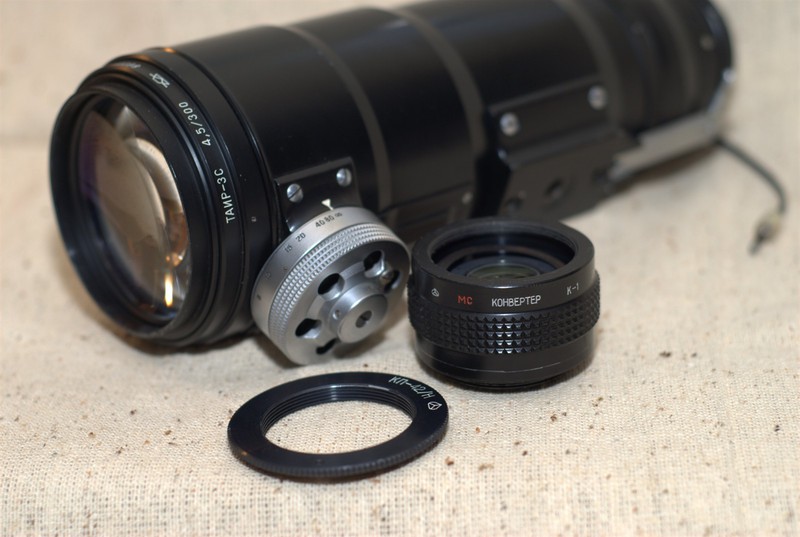
Tair-3S, K-1 MS, KP-42 \ N
I had an idea to use Soviet lenses with M42 thread and the K-1 MS teleconverter with M42 screw connection on a Nikon camera in conjunction with the KP-42 \ N adapter.
The question was: How to remake the teleconverter so that there is infinity?
The lens inside looks like a monolithic glass with three lenses, controls and an electric circuit for transmitting the aperture value to the exposure meter of the Zenith camera. To achieve the result (infinity), it is necessary to approximate the lens with the adapter KP-A \ 42 and KP-42 \ N by 3 mm, and for this you need to grind 3 mm glasses of type A and 3 mm adapter KP-A \ 42. This is the wrong move. Sawing sleeve A will not work for two reasons: (once) no adapters will be attached to the lens, (two) we will not be able to screw the adapter KP-A \ 42 with screws, since we cut 3mm to the middle of the holes for these screws and they will fall out.

Tair-3C. Mount Type A
Started to measure the width of the adapters and found a difference of 2mm.

KP-A \ N
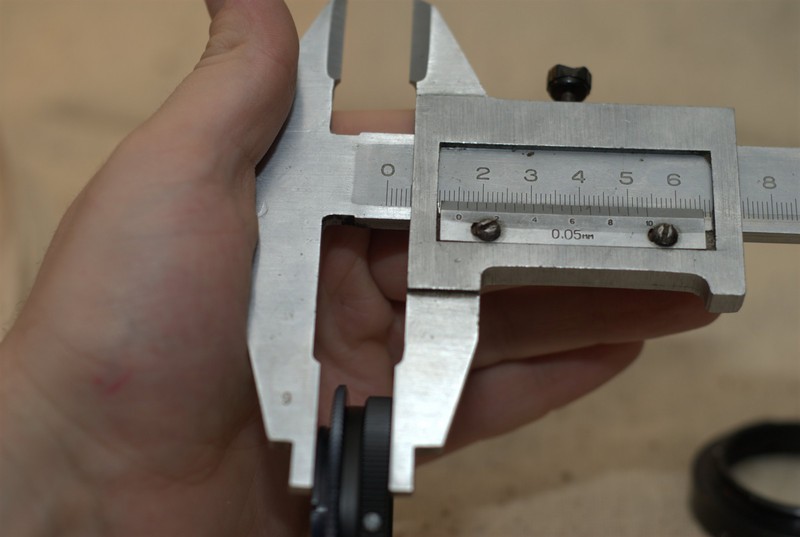
KP-A \ 42, KP-42N
In other words, we need to reduce the width of the converter by 2-3 mm, depending on the thickness of the adapter used.
For reference: The thinnest adapter is Chinese, the average in thickness is the Soviet KP-42 \ N, the thickest is made of stainless steel (it can be homemade or Chinese).
I started to look at how and what can be reduced in the converter in order to bring it closer to 3 mm. It turned out that you can grind 3 mm of the bead, where the sleeve with the M42 thread is inserted.

Converter sleeve and M42

3mm shear

3mm to cut
mark can be put sharp end of the rod-compasses, preset 3mm. It is necessary to fix it firmly so that the part does not jump out of the vise when working with it; you should also hide the converter lenses from metal dust.
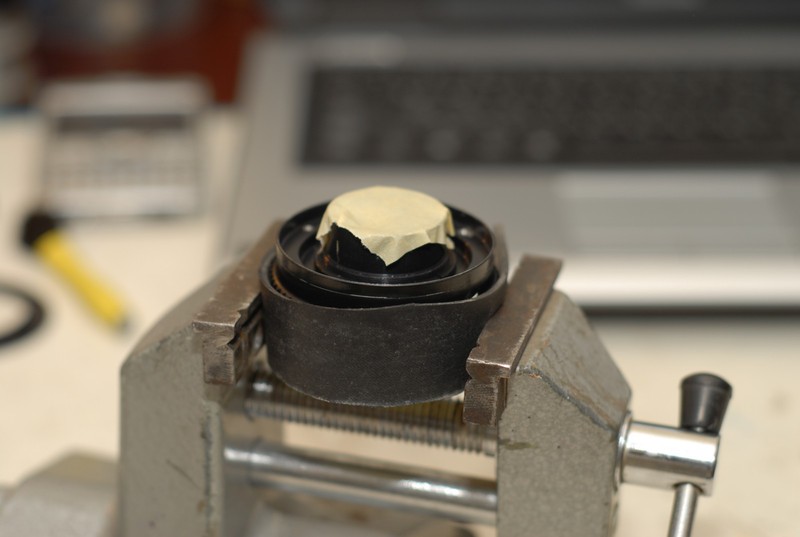
It was possible to cut the board of the converter independently and without problems, but with the M42 sleeve I turned to the turners with a request to cut the 3mm case, because at home it didn’t work out neatly and beautifully due to the lack of a machine or sharpener, but it took a long time to file.
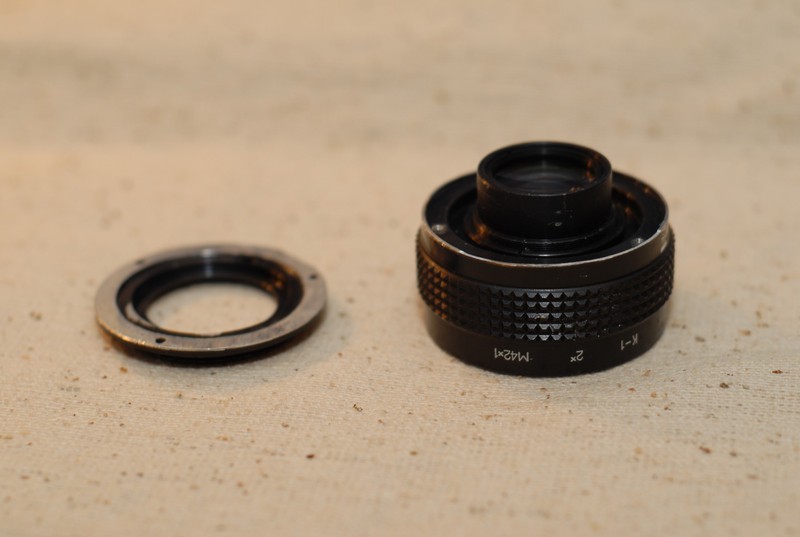
After reducing the details of the converter: the M42 bushings and the bead, make sure that the width is the same on all sides. This can be done using a caliper.

If the width in one of the sections is less, it is recommended to lay a gasket. You can fix it with glue.

After installing the gasket (or gaskets), fix the sleeve with screws. If necessary, clean the part from dust and glue.
To give a beautiful look and hide the traces of our work, an open metal area can be painted. Matte spray paint is suitable for this.
Warning: it is necessary to work with paint in a well-ventilated, non-residential premises, having previously protected hands (gloves), open parts of the body (dressing gown), airways (mask) and eyes (glasses). Spray paint should be applied in layers at a distance of at least 30 cm from the part. The drying period of the paint is from 10 minutes to 24 hours. Dry the part in a non-residential premises.

section for painting

after painting
after the painting work is necessary to give the paint to dry.
When the paint dries, we can begin the final phase of the operation: little baubles and testing the part.
To reduce the time to search for the working position of the parts, you can mark with dots, then drill (shallow, 0.5-07mm) holes and paint them with red acrylic paint.
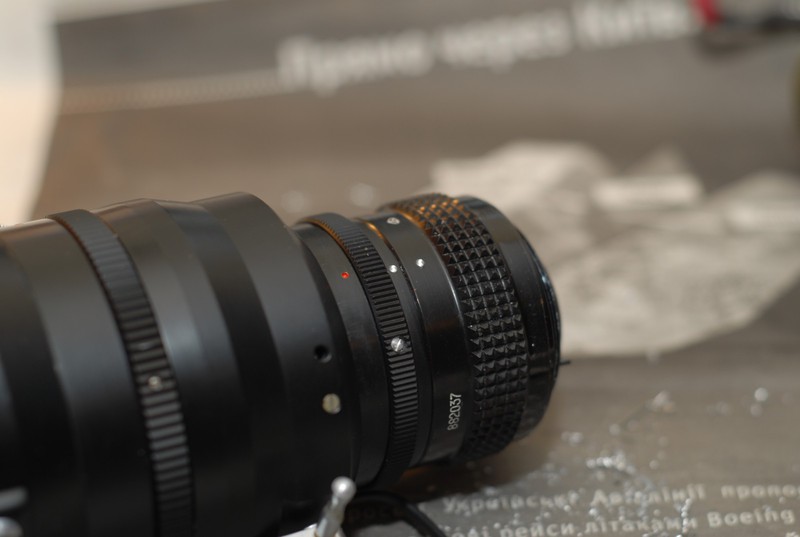
preparation of the mark;

ready mark
. The holes should be filled with rubber gloves. Remove paint residues with a cloth, and smears with a cloth moistened with water.
Testing is the last step. For example, a frame shot with a camera with a Nikkor 50mm lens and a frame shot with a Tair-3C lens, the K-1 MS Tele-converter and the Photosniper-12 butt.

view from the window, Nikkor 50mm

view from the window, Tahir-3C + TK-1
By the way, infinity using teleconverter TK-1 and any lens with M42 threaded connection to the Nikon system, we have achieved. Hurrah!
A few photos of the Nikon D200 + Tair-3C + TK-1 + butt photosniper-12 kit.
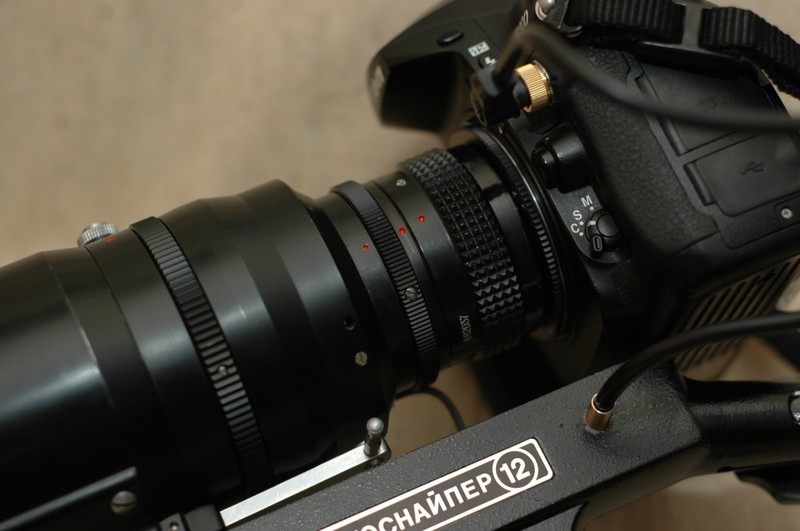

The embodiment of ideas!
remake the K-1 teleconverter so that there is infinity on the Nikon system.

Tair-3S, K-1 MS, KP-42 \ N
I had an idea to use Soviet lenses with M42 thread and the K-1 MS teleconverter with M42 screw connection on a Nikon camera in conjunction with the KP-42 \ N adapter.
The question was: How to remake the teleconverter so that there is infinity?
The lens inside looks like a monolithic glass with three lenses, controls and an electric circuit for transmitting the aperture value to the exposure meter of the Zenith camera. To achieve the result (infinity), it is necessary to approximate the lens with the adapter KP-A \ 42 and KP-42 \ N by 3 mm, and for this you need to grind 3 mm glasses of type A and 3 mm adapter KP-A \ 42. This is the wrong move. Sawing sleeve A will not work for two reasons: (once) no adapters will be attached to the lens, (two) we will not be able to screw the adapter KP-A \ 42 with screws, since we cut 3mm to the middle of the holes for these screws and they will fall out.

Tair-3C. Mount Type A
Started to measure the width of the adapters and found a difference of 2mm.

KP-A \ N

KP-A \ 42, KP-42N
In other words, we need to reduce the width of the converter by 2-3 mm, depending on the thickness of the adapter used.
For reference: The thinnest adapter is Chinese, the average in thickness is the Soviet KP-42 \ N, the thickest is made of stainless steel (it can be homemade or Chinese).
I started to look at how and what can be reduced in the converter in order to bring it closer to 3 mm. It turned out that you can grind 3 mm of the bead, where the sleeve with the M42 thread is inserted.

Converter sleeve and M42

3mm shear

3mm to cut
mark can be put sharp end of the rod-compasses, preset 3mm. It is necessary to fix it firmly so that the part does not jump out of the vise when working with it; you should also hide the converter lenses from metal dust.

It was possible to cut the board of the converter independently and without problems, but with the M42 sleeve I turned to the turners with a request to cut the 3mm case, because at home it didn’t work out neatly and beautifully due to the lack of a machine or sharpener, but it took a long time to file.

After reducing the details of the converter: the M42 bushings and the bead, make sure that the width is the same on all sides. This can be done using a caliper.

If the width in one of the sections is less, it is recommended to lay a gasket. You can fix it with glue.

After installing the gasket (or gaskets), fix the sleeve with screws. If necessary, clean the part from dust and glue.
To give a beautiful look and hide the traces of our work, an open metal area can be painted. Matte spray paint is suitable for this.
Warning: it is necessary to work with paint in a well-ventilated, non-residential premises, having previously protected hands (gloves), open parts of the body (dressing gown), airways (mask) and eyes (glasses). Spray paint should be applied in layers at a distance of at least 30 cm from the part. The drying period of the paint is from 10 minutes to 24 hours. Dry the part in a non-residential premises.

section for painting

after painting
after the painting work is necessary to give the paint to dry.
When the paint dries, we can begin the final phase of the operation: little baubles and testing the part.
To reduce the time to search for the working position of the parts, you can mark with dots, then drill (shallow, 0.5-07mm) holes and paint them with red acrylic paint.

preparation of the mark;

ready mark
. The holes should be filled with rubber gloves. Remove paint residues with a cloth, and smears with a cloth moistened with water.
Testing is the last step. For example, a frame shot with a camera with a Nikkor 50mm lens and a frame shot with a Tair-3C lens, the K-1 MS Tele-converter and the Photosniper-12 butt.

view from the window, Nikkor 50mm

view from the window, Tahir-3C + TK-1
By the way, infinity using teleconverter TK-1 and any lens with M42 threaded connection to the Nikon system, we have achieved. Hurrah!
A few photos of the Nikon D200 + Tair-3C + TK-1 + butt photosniper-12 kit.


The embodiment of ideas!
PS I am not the author of the post. I publish at the request of my friend, areal photomaniacwho does not yet have an account on Habr, if someone suddenly has a desire, you can send an invitation to the topic’s author by e-mail nautilus.is.back [at] gmail.com
